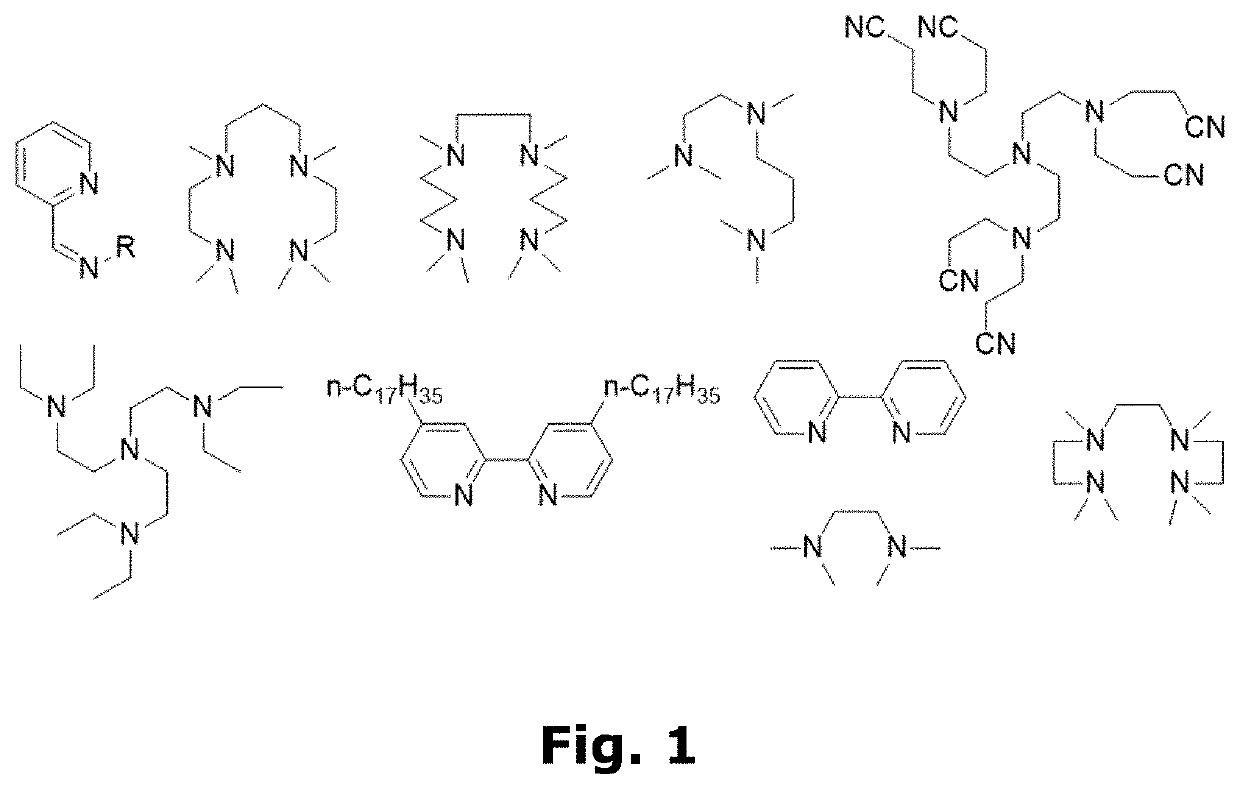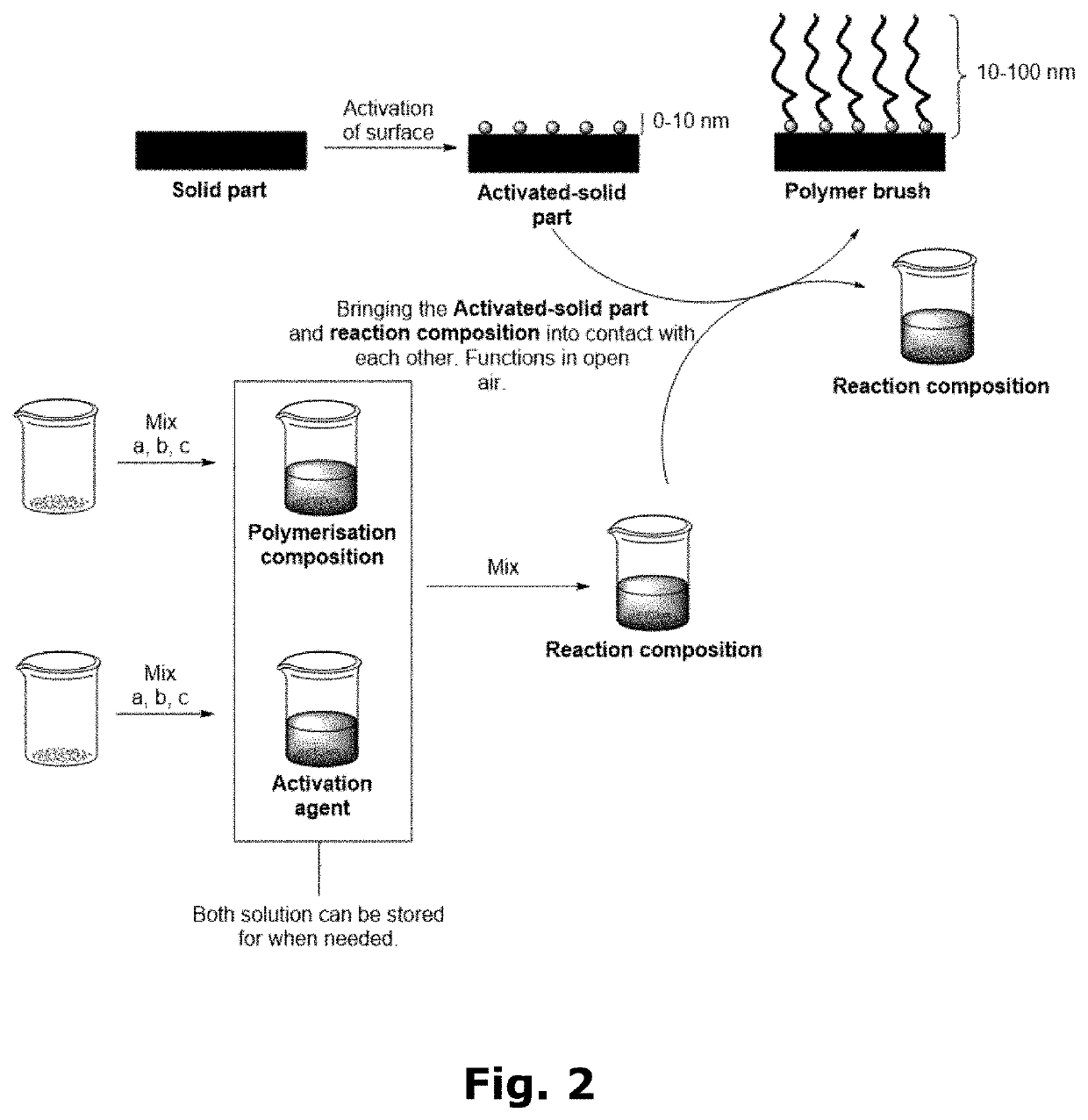Compositions for forming polymer brushes
- Summary
- Abstract
- Description
- Claims
- Application Information
AI Technical Summary
Benefits of technology
Problems solved by technology
Method used
Image
Examples
example 1
Preparation of Polymer Brushes from 2-Hydroxyethyl Methacrylate (HEMA)
[0100]Preparation of the Polymerisation Composition:
[0101]12 mL water, 6 mL methanol (MeOH), 12 mL HEMA, and 0.2208 mL N,N,N′,N″,N″-pentamethyldiethylenetriamine (PMDETA—ligand) were mixed in a flask. To the flask was added a Cu wire wrapped Teflon magnet which was rotated in the flask at 400 rpm for 2 or 5 hours, depending on the desired concentration of Cu spices. The two different arbitrary Cu concentrations were denoted “2 / 5” and “5 / 5”. Afterwards the Cu wire wrapped Teflon magnet was removed, and the solution was stored at 2-5° C. until use.
[0102]Polymerisation in 5 / 5 Solution:
[0103]5 mL of 5 / 5 polymerisation composition was argon purged for 3 minutes. Now 9 mg / mL of NaAsc (activation agent) was added to the polymerisation composition, thus, forming the reaction composition, together with an activated solid part (glassy carbon). The reaction composition was stirred together with the activated solid part (glas...
example 2
Preparation of Polymer Brushes from Glycidyl Methacrylate (GMA) Monomers
[0119]Preparation of Polymerisation Compositions with Different Cu Concentrations:
[0120]A Cu-wire wrapped Teflon magnet was stirred for 30 minutes in a solution of 5 mL DI-water and 0.050 mL PMDETA. Afterwards, the Cu-wire wrapped Teflon magnet was flushed with HPLC-acetone and was transferred to another glass container.
[0121]Now, to the second glass container with the prepared Cu-wire wrapped Teflon magnet 32.46 mL MeOH, 32.46 DI-water, and 0.729 mL N,N,N′,N″,N″-pentamethyldiethylenetriamine (PMDETA—ligand) were added. The Cu-wire wrapped magnet was stirred in the solution at 400 rpm for a sufficient time to yield the desired concentration of Cu catalyst spices. Afterwards, the Cu-wire wrapped Teflon magnet was removed, 9.99 ml GMA was added, and the solutions were stored at 2-5° C. until use.
[0122]The concentration of the Cu catalyst in each of the solutions was determined using atomic adsorption spectroscopy ...
example 3
Preparation of Polymer Brushes from Methyl Methacrylate (MMA)
[0189]Preparation of the Polymerisation Composition:
[0190]6 mL iso-propanol and 0.088 mL N,N,N′,N″,N″-pentamethyldiethylenetriamine (PMDETA—ligand) were stirred for 2 hours and 45 minutes with a Cu-wire wrapped Teflon magnet. Subsequently, 6 mL MMA was added to the solution, and the Cu-wire wrapped Teflon magnet was removed. The obtained polymerisation composition was stored at 2-5° C. until use.
[0191]The Polymerisation in Solution:
[0192]5 ml of the above described polymerisation composition was argon purged for 3 minutes. Subsequently, 5 mg / mL of NaAsc (activation agent) as powder was added to the polymerisation composition, thus, forming the reaction composition, together with an activated surface. The reaction composition was stirred together with the activated solid part (glassy carbon) for 60 minutes.
[0193]After the polymerisation, the now polymer brush coated solid part was removed from the solution and washed by son...
PUM
| Property | Measurement | Unit |
|---|---|---|
| Volume | aaaaa | aaaaa |
| Volume | aaaaa | aaaaa |
| Volume | aaaaa | aaaaa |
Abstract
Description
Claims
Application Information
 Login to View More
Login to View More - R&D
- Intellectual Property
- Life Sciences
- Materials
- Tech Scout
- Unparalleled Data Quality
- Higher Quality Content
- 60% Fewer Hallucinations
Browse by: Latest US Patents, China's latest patents, Technical Efficacy Thesaurus, Application Domain, Technology Topic, Popular Technical Reports.
© 2025 PatSnap. All rights reserved.Legal|Privacy policy|Modern Slavery Act Transparency Statement|Sitemap|About US| Contact US: help@patsnap.com



